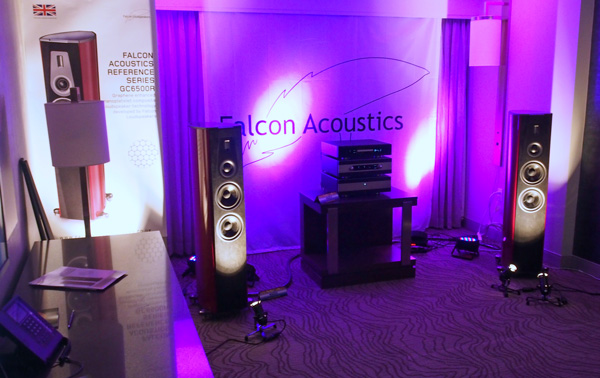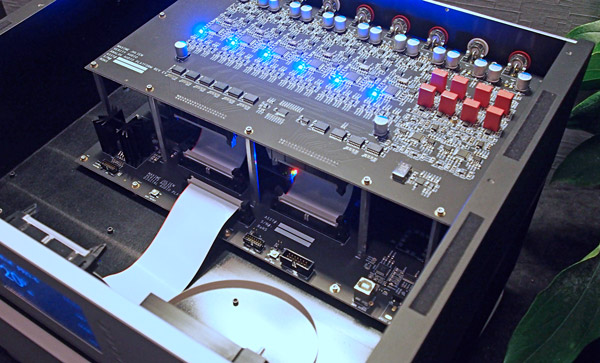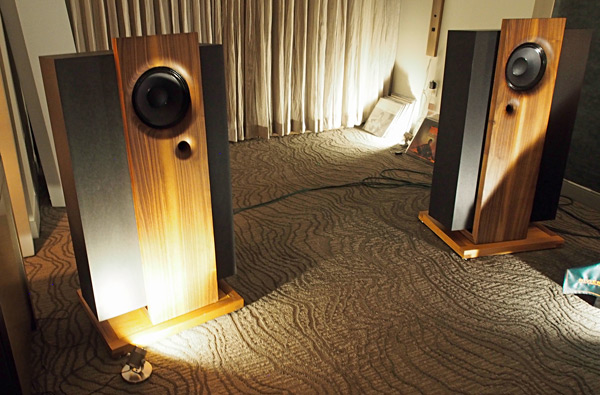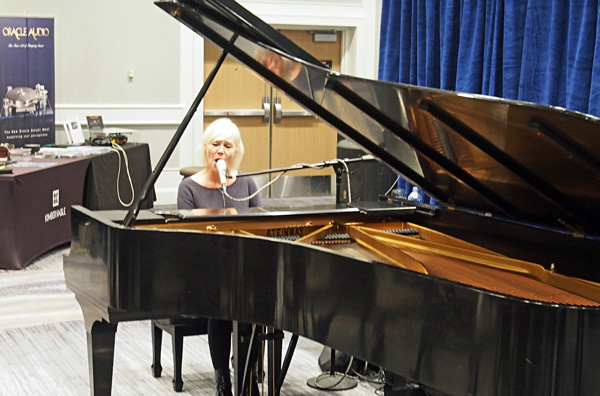| Columns Retired Columns & Blogs |
1855 mile drive home listening to ..........
"Car Radio" ............ twenty one pilots :-) ............

Despite the power-hungry DSP inside, the Mobius's battery life is said to be 10 hours—charging is via a USB port—and the Mobius also has Bluetooth connectivity, with a mike included for phone calls.. Keith, Paul, and I all tried it and the Mobius works as claimed. Impressive.

Jason Serinus has already reported on the PS Audio room at RMAF, where the Colorado company was playing the late Arnie Nudell's final prototype loudspeakers. As Jason wrote, this speaker's design features will become the basis for a new line of Arnie Nudell loudspeakers from PS Audio, which should debut, God willin' and the creek don't rise, in Q4 2019.
PS's Paul McGowan handed me his iPad and asked to choose something from streaming service Qobuz and in a Rachmaninov mood, I chose André Previn's performance of the Symphony 2 with the Royal Philharmonic Orchestra on Telarc. I had been present at one of the sessions for this recording and such was the powerful sweep of the sound produced by the Nudell speakers, driven by PS Audio BHK Signature monoblocks, that I was transported back to England's Walthamstow Town Hall in March 1985. Audio system as time machine!

Herb Reichert is a big fan of the version of the classic BBC LS3/5a minimonitor produced by Falcon Acoustics, but when I went into this English manufacturer's room on the 5th floor of the Marriott's Atrium wing, I was greeted by their new Reference GC6500R towers ($26,000/pair), bathed in violet light. The sound with the speakers driven by a Primare A60 amplifier and Primare CD35 Prisma CD player and hooked up with StraightWire cables, was full-range, uncolored, and transparent. The GC6500R combines a true ribbon tweeter with a waveguide-loaded 2" soft-dome midrange unit, but it was the twin 7" woofers that caught my attention. These use what Falcon calls a "Graphene Enhanced Nano-Platelet Composite Cone."
Graphene is a form of carbon where the atoms are assembled in a thin sheet just a few atoms thick. In Falcon's woofer cones, the graphene sheets are suspended in the resin that's used to make the diaphragm from woven carbon-fiber mats. When the composite material is cured, the graphene provides crosslinking between the carbon fibers that dramatically increases stiffness.
While I was in this room, Falcon's Jerry Broomfield appeared and took me to the other Falcon room in the Marriott's tower, where he was doing a unique comparison between several versions of the LS3/5a produced between 1968 and 2018, including a remake of the first LS3/5 version. (He repeated the comparison the following day in a seminar that should be available on YouTube, but I had already hit the road for home by then.)

We rushed forward publication of our November issue so we would have it at the show. One of the reviews in that issue was of the Doshi monoblock V3.0 power amplifier and that was I was expecting to see and hear when I went into the room shared by Doshi and Joseph Audio. Speakers were the $12,999/pair Joseph Perspectives I favorably reviewed in July 2014 but the amp, hooked up with Cardas cabling, was a Doshi stereo design ($19,995), using paralleled push-pull EL34s to produce 75Wpc. Nick Doshi told me that the amplifier was intended to have the minimum number of gain stages and that the input stage used JFETs.
The rest of the system was an Aurender A10 server/DAC ($5000) streaming files from Qobuz, a Dosji Line Stage V3.0 ($17,995) and an open-reel recorder fitted with Nick's tape-head preamp, these sitting on an HRS rack. I listened to a lot of music in the room, including a demo of Paul Simon's "Train in the Distance" from Hearts & Bones, where Simon accompanied himself on guitar, a live recording of jazz vocalist Cecile McLorin Salvant singing in French, and one of Jeff Joseph's own recordings of a superb high-school big band, which he had used a spaced pair of Joe Grado omni mikes. It was difficult to tear myself away from this great-sounding room but I was running out of time and had miles to go before I could sleep!

Jason has written how impressed he was by the sound of the million-dollar Verity system in the High Fidelity Services room. I was also impressed, this system offering high dynamic-range music with an enormous sweep of sound, superb stereo imaging, smooth, detailed highs, an uncolored midrange, and extended lows without a trace of harmonic distortion. But the star of the Verity Montsalvat speaker system was the Pro-6, which provides all the DSP correction, crossover functions, and time alignment of the subwoofer towers (these working below 60Hz) with the main speakers.
It digitizes analog input signals at 384kHz with 24-bit word length, or accepts USB and S/PDIF digital inputs—PCM and DSD data are handled—and performs all the necessary processing with an FPGA chip capable, I was told, of performing 93 billion operations per second, before converting the resultant drive-unit signal back to analog. A two-channel version, the Pre 2, is in development.

"Say a prayer for the cowgirl. . ."— the over-familiar lyrics from Jennifer Warnes' and Rob Wasserman's recording of Leonard Cohen's "Ballad of the Runaway Horse" was playing when I entered the CH Precision room. But such was the inviting nature of the sound that I stayed a while. Michael is a big fan of the CH phono preamp and Jason Serinus is about to review the CI1 integrated amplifier (with DAC and phono stage ($38,000); the C1 DAC DAC ($73,000) was hooked up to an external power supply ($17,000) and an external clock ($28,600), but I was drawn to the Göbel Epoque Aeon Reference loudspeakers ($220,000/pair) that were being driven by CH M1 monoblocks ($108,000) and a L1 preamplifier ($58,000).
The room was well-treated acoustically but the speakers must have also been doing things right as the stereo imaging was superb, stable and palpable images hanging between and behind the speaker plane, and the low frequencies were extended, powerful, and without boom. The Göbel speaker uses a single bending-wave drive-unit to cover the range from 160Hz to 30kHz, and despite the low efficiency of this kind of drive-unit, the Epoque Aeon's claimed sensitivity was a respectable 86dB.

Another unusual loudspeaker was to be found in the Tone Imports room. The two-way Meyer Tonapparate Yonna speaker ($14,500/pair) doesn't have a crossover but combines a horn-loaded tweeter with a 10" paper-cone woofer loaded with both a horn and a unique "flapping baffle" made from spruce to its rear, this reminiscent of a Bösenforfer speaker from a decade ago. Claimed sensitivity is an extraordinary 97dB/W/m! With the front end a Verdier La Platine turntable ($13,995) fitted with Art Dudley's favorite EMT 997 tonearm ($5995) and a Sumile Stereo MC cartridge ($8495) and preamp ($35,000) and amplification ($40,000) from Italian company Riviera Labs, a Count Basie recording sounded warm and friendly, but with a rather boxy lower midrange.

I suppose it fair to say that Wavelength's room featured a similarly idiosyncratic system. However, the sound of this room, the second-to-last one I visited, was superb. I listened Elvis Presley, Bonnie Raitt, John Lee Hooker . . . I didn't want to leave. The big Vaughn speakers were used with (I think) a REL subwoofer and were being driven by Wavelength's SET amplifiers and use a remanufactured Dukane plasma tweeter. I was tempted to name this as "Tweeter of RMAF," so clean and uncolored were the high frequencies.
Wavelength's Gordon Rankin showed me a NOS tube he was using in his preamp, a 6418, which I had never heard of and is, of all things, a directly heated small-signal triode! This isn't rare, was made in 1982 for "mobile headphone use"—my mind boggled—and is available from resellers for just 73¢ each.

The firs time I went into the huge Kimber room to listen to the 4-channel system based on the ginormous Focal Grand Utopia EM Evo 4 speakers—see Jason's report for the system details—playback had been suspended for a live performance by Canadian singer/pianist Anne Bisson. Time, too, was suspended as I listened to Ms. Bisson perform two songs—and props to Ray Kimber for making sure the 9' Steinway was perfectly in tune! But as with the Legacy room I mentioned in my first RMAF report, some of the visitors in the room didn't feel any need to suspend their conversations to listen to the music. What's wrong with these people!?!?!
When I returned to this room at the end of the next day, I listened to a surround IsoMike recording—a track from tenor sax player Joe McQueen's Ten at 86—and was blown away by the envelopment of the sound. Experiences like this are what make attending audio shows worth the effort, I mused as I started my 1855-mile drive home to Brooklyn Sunday morning. (Three days on the road with my thoughts, my music, and some occasionally spectacular scenery are what passes for a vacation in a magazine with a monthly publishing schedule :-)

1855 mile drive home listening to ..........
"Car Radio" ............ twenty one pilots :-) ............

Dude, where is my car? :-) ............

Now that Jana and Stephen are gone have you considered bringing in some younger ears? I know that, even without the damage I've done to my ears from the bands that I've been in, the concerts that I've been to, and the speakers and headphones that I've listened to turned up too loud, at my age I have significant high frequency loss. And I know that JA, Herb, Mikey, and Jason are my age or older, so you all must have lost the highs as well, 'cause I know you all also listen loudly, and JA is a bass player. So, how can you objectively evaluate the top octave on systems that you're reviewing and reporting on when you can't hear a significant portion of the top octave, at least above 15khz.
I know that when I was young and my wife and I would go listen to speakers at audio stores, some of the speakers that were highly rated by reviewers had rolled off highs, and sounded muffled to us, but the reviewers were all middle aged men, so they couldn't hear the attenuated high end.
When I studied electronics in college, and when we had lab with small B&W TVs, the 15.75khz horizontal frequency that drives the CRTs would be screaming at us, with 30 of them on and their chassis out of their cases at the same time, but the Prof. couldn't hear it, 'cause he was in his fifties. Just saying it's something to consider.

I don't think that a system would sound the least muffled if the highs were good to 15 khz. It would be less "airy", but hardly muffled. -- speaking of the system or the ears listening to it.

Maybe muffled was a bad choice of words, but I do remember that many highly acclaimed speakers sounded lacking in highs to us. Perhaps we just preferred brighter sounding speakers vs. warmer ones.

Some speaker designs have had a problem with highs - planars (not electrostats) come to mind. Today, planar headphones are all the rage, and while I haven't heard any of the $2000 to $4000 planars, of those that I've heard below $2000, the only one with a halfway decent treble was a Fostex T50rp modification.
Another important and usually neglected area of high-frequency judgement is the time of day and particular circumstances. For some reason, I not only hear better in the wee hours of the morning due to extremely low levels of background noise at home, but upper treble tones and their harmonics are clearer and stronger, and that's with clean ears. I've read about that in a couple of places, but it's way underreported.
I mention this because there not only are higher average levels of noise at audio shows, but the circumstances (attendees are not relaxed and able to fine-tune) are such that most people would probably not be able to evaluate the fidelity of an item at a show anywhere near as well as they could at home. Supposedly the professionals can, but I'd bet they can't hear as clearly at shows, and they've learned to listen for audio clues that give them a high probability of pre-judging the items with reasonable accuracy.
Same deal goes for older professionals - certain learned techniques and an expert hand on the volume control or EQ slider goes a long way to compensate for a modest reduction in the perception of highs.

I'm a big proponent of tone controls, 'cause I think they can enhance the listening experience if used conservatively. But, now most Audiophiles poo-poo them as a no-no, claiming that they destroy the sound quality of a preamp or integrated amp. About the only high-end gear that I know of that still offers them are Macintosh, Luxman, and Marantz. And I remember in the 70's many speakers had controls (adjustable L-pads) to adjust the level of the midrange and tweeter. Very few, if any, feature those now.

Not for general use, but for testing purposes, as an extra check on subtle differences. Let's say you suspect that a tweeter is producing a slightly distorted tone around 14 khz, but your hearing may be a little shy there and the tweeter output low in volume. So you play around with volume and EQ and whatever else you have - phase switching or 50 other things, to be sure there is or isn't a specific problem.
In the broader sense of reviewing, if the reviewer's hearing is minimally adequate/normal and s/he is satisfied with how things sound in the real world, including live music, then if the reviewer's system sounds equally natural, they are most of the way there. The remainder is pinning down the anomalies, and that's where the smart reviewer knows how to apply the tools of the trade.

Legacy Audio also makes external EQ/DSP units ........... JA writes briefly about Legacy Wavelet in his show reports ......... You can check Legacy Audio website for more info ...........

Whatever HF hearing loss might be expected from hi-aged reviewers, the same should also be expected nowadays from similarly aged customers/readers: a pre-established harmony of sorts. That's one reason why your average celebrated mega-buck system sounds downright shitty to virgin ears and minds of all ages. Hi-fi survivors may consider themselves modern by scorning "physical media" and behemoth hardware, but they’ll have some really hard time explaining to next generation music geeks what purpose a music server supposedly serves.

What sounded shitty to me at age 26 did not sound any better at age 56. Maybe that will change in another 10 years, but I'm not optimistic. Remember the meme where you're eyeing someone in a bar and they get better looking after a few beers? It isn't the beer, it's just the recklessness granted by the alcohol. Good recordings age well, especially when they're eventually remastered by someone who knows what they're doing and cares a lot about getting the best sound.

I've noticed, from looking at the measurements, that many speakers these days seem to be designed intentionally with a rising treble. I've always wondered if that's for their target audience of us older folks (to compensate for our high frequency losses) or if it's to make explosions and other sound effects in movies more exciting, or perhaps both.

I'm no longer a big-speaker expert, having switched to headphones and small speakers 20 years ago. But I can say that headphones - even the very expensive - are all over the map in that respect. I seem to remember the Stax electrostats being bright, and today one manufacturer's (Beyerdynamic) TOTL headphones have some serious emphases as high as 14 khz, but other than the most common peaks around 9 khz or lower, most headphones aren't tuned for a rising upper treble.
If the tech measurements for audiophile speakers don't show a rising upper treble, then I'd think the room surfaces would have a lot to do with the treble energy, unless you sit pretty close. But if you've got money and a good-size room with pricy speakers, why sit close?
Edit: If you have a couple of examples of rising upper-treble measurements where the review doesn't describe the effect, that might be worth looking into.

The cell phone has given the world its own radio station and now the art of being quiet is totally gone. I have never seen the need to speak and be heard so prevalent as it has been in the past 10+ years. It seems that people must verbalize everything inside their heads these days, including students in the classroom, a serious problem. This you talk about is just rudeness at its peak, but no surprise as we look about the world we live in. Sad.

"Vanity is definitely my favorite sin" -- Devil's Advocate.

Hi JA - I think a zero is missing from the price of the Gobel speakers......

I found the coverage of the biggest consumer audio show in the U.S. lacking. You and Jason covered a lot of the rooms with more expensive equipment. You needed an additional person like Herb Reichert to cover the rooms with less expensive equipment. Hopefully you will do better at future shows.

In sentence beginning "The rest of the system was an Aurender A10 server/DAC ($500) ..." there should be another zero in the price, I'm thinking. (At least?) Clearly just a typo, but if someone didn't know, he might get all sorts of excited, only to be disappointed upon learning the truth.

Poor coverage of the best US Audio show.
Where is herb when you need him?

Herb is busy chasing away those birds eating his tomatoes :-) ............

Herb is tending to his herbs.

Herb once said that, he was worried about the birds eating his tomatoes :-) .........

The eating part isn't so bad, but when they leave things behind that get into your soup....

John,
It was great to see you at the show.
The sub was the MJ Acoustic Kennsington, push pull 10". This was designed by the engineers who use to work at REL. Nice sub has 4 presets so you can change the aspects depending on song.
I have no affiliation to MJ Acoustics.
Thanks,
Gordon